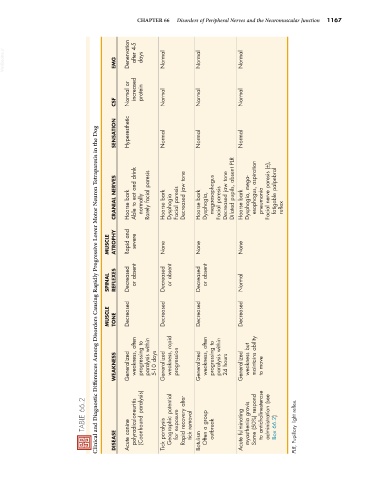Page 1195 - Small Animal Internal Medicine, 6th Edition
P. 1195
CHAPTER 66 Disorders of Peripheral Nerves and the Neuromuscular Junction 1167
VetBooks.ir EMG Denervation after 4-5 days Normal Normal Normal
Normal or increased protein Normal Normal Normal
CSF
SENSATION Hyperesthetic Normal Normal Normal
Clinical and Diagnostic Differences Among Disorders Causing Rapidly Progressive Lower Motor Neuron Tetraparesis in the Dog
CRANIAL NERVES Hoarse bark Able to eat and drink normally Rarely facial paresis Hoarse bark Dysphagia Facial paresis Decreased jaw tone Hoarse bark Dysphagia, megaesophagus Facial paresis Decreased jaw tone Dilated pupils, absent PLR Hoarse bark Dysphagia, mega- esophagus, aspiration pneumonia Facial nerve paresis (±), fatigable palpebral reflex
MUSCLE ATROPHY Rapid and severe None None None
SPINAL REFLEXES Decreased or absent Decreased or absent Decreased or absent Normal
MUSCLE TONE Decreased Decreased Decreased Decreased
WEAKNESS Generalized weakness, often progressing to paralysis within 5-10 days Generalized weakness, rapid progression Generalized weakness, often progressing to paralysis within 24 hours Generalized weakness but maintains ability to move
TABLE 66.2 polyradiculoneuritis (Coonhound paralysis) Geographic potential for exposure Rapid recovery after tick removal Often a group myasthenia gravis Some (50%) respond to anticholinesterase administration (see Box 66.2) PLR, Pupillary light reflex.
DISEASE Acute canine Tick paralysis Botulism outbreak Acute fulminating

